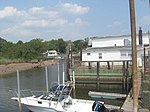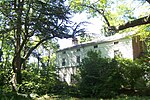St. Joseph by the Sea High School
1963 establishments in New York CityEducational institutions established in 1963Roman Catholic high schools in Staten IslandWikipedia indefinitely semi-protected pages

St. Joseph by-the-Sea High School (also known as SJS or Sea) is a co-educational Catholic school in the Huguenot neighborhood of Staten Island, New York, United States. Though technically an independent school with its own board of trustees, it functions for all intents and purposes as a school of the Roman Catholic Archdiocese of New York. The school serves approximately 1,200 students in 9th, 10th, 11th and 12th grades.
Excerpt from the Wikipedia article St. Joseph by the Sea High School (License: CC BY-SA 3.0, Authors, Images).St. Joseph by the Sea High School
Hylan Boulevard, New York Staten Island
Geographical coordinates (GPS) Address Nearby Places Show on map
Geographical coordinates (GPS)
| Latitude | Longitude |
|---|---|
| N 40.525555555556 ° | E -74.176666666667 ° |
Address
Hylan Boulevard 5150
10312 New York, Staten Island
New York, United States
Open on Google Maps







